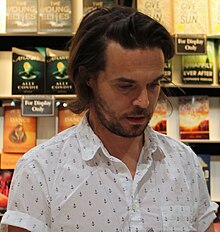Oliver Jeffers
| Oliver Jeffers | |
|---|---|

Oliver Jeffers in 2014
|
|
| Born | 1977 (age 39–40) Port Hedland, Western Australia |
| Nationality | Northern Irish |
| Education | University of Ulster |
| Website | oliverjeffers |
Oliver Jeffers (born 1977) is a Northern Irish artist, illustrator and writer who now lives and works in Brooklyn. He went to the integrated secondary school Hazelwood College, then graduated from the University of Ulster in 2001.
From figurative painting and installation, to illustration and picture-book making, his work has been exhibited in New York, The Brooklyn Museum, Berlin, Dublin, London, Sydney, Washington DC, and Belfast.
He is widely known for his picture books for children, published by HarperCollins UK and Penguin US. How to Catch a Star debuted in 2004 to critical acclaim, and Lost and Found (2005), won the Nestlé Smarties Book Prize Gold Medal 2006, the Blue Peter Book Award 2006 and was shortlisted for the Kate Greenaway Medal the same year. The Incredible Book Eating Boy (2007) won the Irish Book Awards Children's Book of the Year, and his fourth Book The Way Back Home was released in September 2007 and The Great Paper Caper was released in September 2008. Stuck & This Moose Belongs to Me were both on The New York Times Best Seller list. Jeffers' books have been translated into German, Spanish and French among other languages.
The Day the Crayons Quit achieved No. 1 on The New York Times Best Seller list.
Jeffers' style of illustration uses mixed media and is recognised for its subtle narrative and use of space in composition. As a freelance illustrator he has worked for clients such as Orange UK, Lavazza, Sony PSP, RCA Records, Starbucks, United Airlines, Newsweek, Wired, Irish Times, The Guardian, Creative Review, New York Times, Kinder and The Telegraph.
Jeffers artwork consists of figurative painting executed on either canvas or three-dimensional objects, both found and made. His solo show Additional Information, (Belfast December 2006) studied the balance between form and content by drawing parallels between the arts and sciences, in which figurative oil paintings were over laid with mathematical equations.
...
Wikipedia
